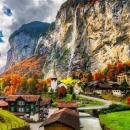
Find Out About Europe's Train Stations
Most European railway stations are centrally located and well served by public transportation, such as trams, subway lines, or buses. A taxi rank is usually situated just outside the station. Tourist offices, bike rental and car rental companies are usually nearby. Here are a few other things you should know for when you are at the station, and also once you have boarded your train.
What you need to know at the station
Finding the Right Station
Larger European cities have multiple train stations. Cities like Paris or Madrid have different train stations depending on your desired destination. Use the Eurail timetable to double-check the station your train departs from before you head out to catch a train.
Facilities at the station
Train stations in major cities are often like mini-cities with a range of facilities. The facilities on offer vary per station but can include: restaurants, postal offices, phone booths, tourist information offices, currency exchange, ATMs, shops, luggage storage, and more.
Station lounges
At some major stations, you may find railway lounges reserved for select customers. In certain countries, these lounges are sometimes available to 1st class Eurail Pass Holders. You can check at the station if your pass qualifies you for access to these lounges.
Finding your train
At the station, you'll find details of departure times and platform listings. At major stations, large computerized boards offer up-to-the-minute schedule and platform information. Station information offices can also provide train schedules.
What you need to know on the train
Getting on and off trains
You’ve checked the schedule and know the departure track, now you’re ready to board! If you’ve made a reservation, you’ll find the car and seat number printed on the ticket. Displays on platforms at some stations show the composition of long-distance and overnight trains, and indicate where your car will stop on the platform. Be ready to board the train the minute it arrives; station stops are often very short.
1st and 2nd class
You can see if a car is 1st or 2nd class by the numbers posted near the train’s door or on a window. Trains can be split and sent in different directions, so make sure the car you’re in is going where you want to go. Once you’ve found your car, finding your seat is easy. If you’ve reserved a seat in a compartment, look for a sign on the compartment door and match the seat number on your ticket to the one on the list. For open car reserved seating, seat numbers are on the headrest.
Are we there yet?
Station stops aren’t always announced, or may be announced in a foreign language. Take note of your scheduled arrival time and the names of the last stations before your stop so you’ll be prepared to exit the train when it arrives at your destination. Station names are clearly visible at platforms.
Bicycles
At most larger train stations there are facilities to rent or store a bicycle. The rules for taking a bike on the train are different per country and sometimes even per train. Sometimes bikes may be carried free of charge, often you have to buy a separate ticket for the bike at the station. Some trains have special compartments for bicycles. There may be rules that you can only bring a bike outside rush hours. You can find information about transporting bicycles at the websites of individual railway companies.
Many high-speed trains don't accept bicycles. To make sure your train accepts bikes, you can consult an online timetable. Besides filling in your destination and the departure date, you can select the option “carriage of bicycles required”. The system will then show you trains that have enough space to carry a selected number of bikes.
Change of currency
You cannot change the currency once you have a Pass in your cart. Remove the Pass, and then change the currency on the website header.





